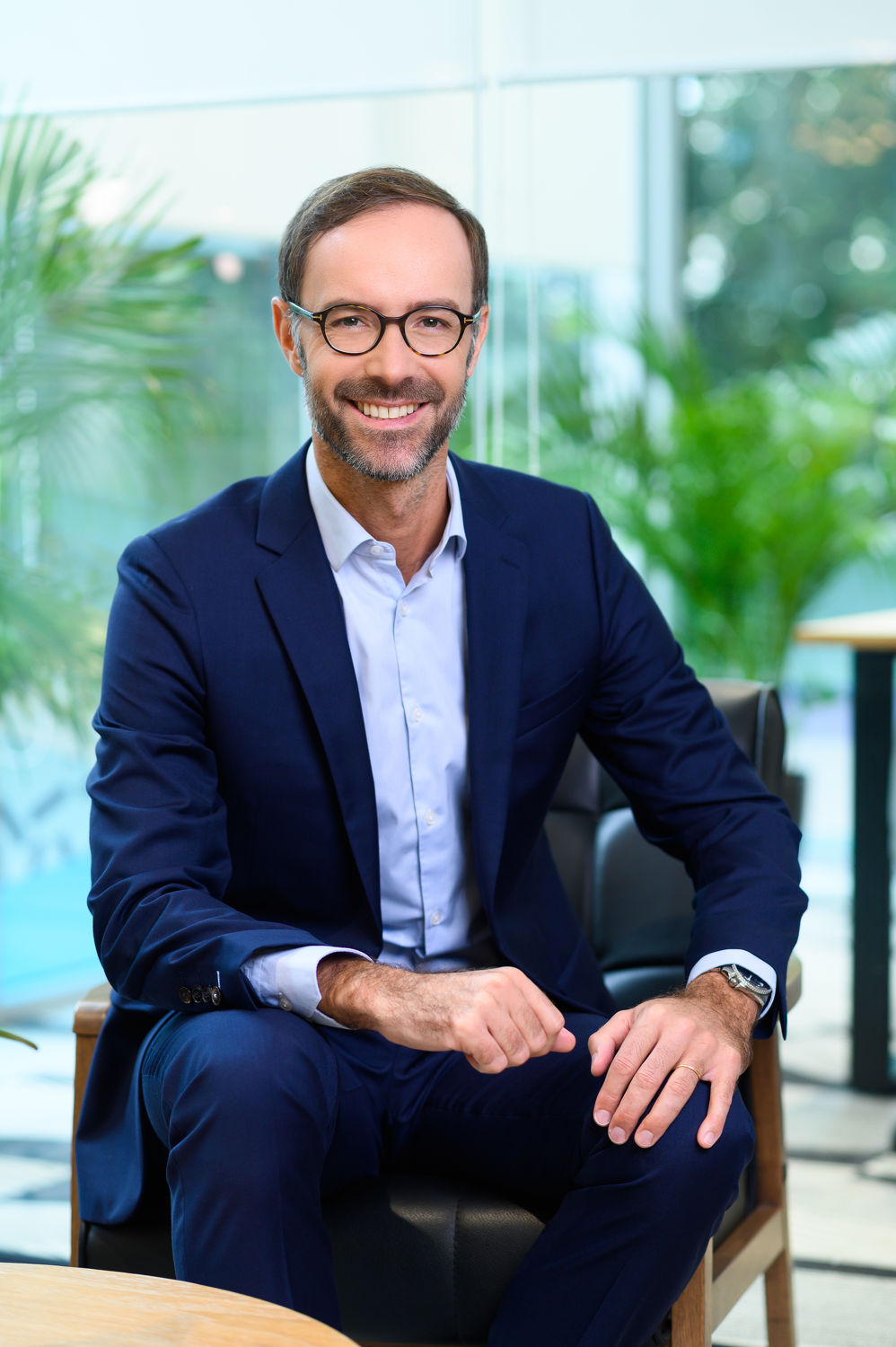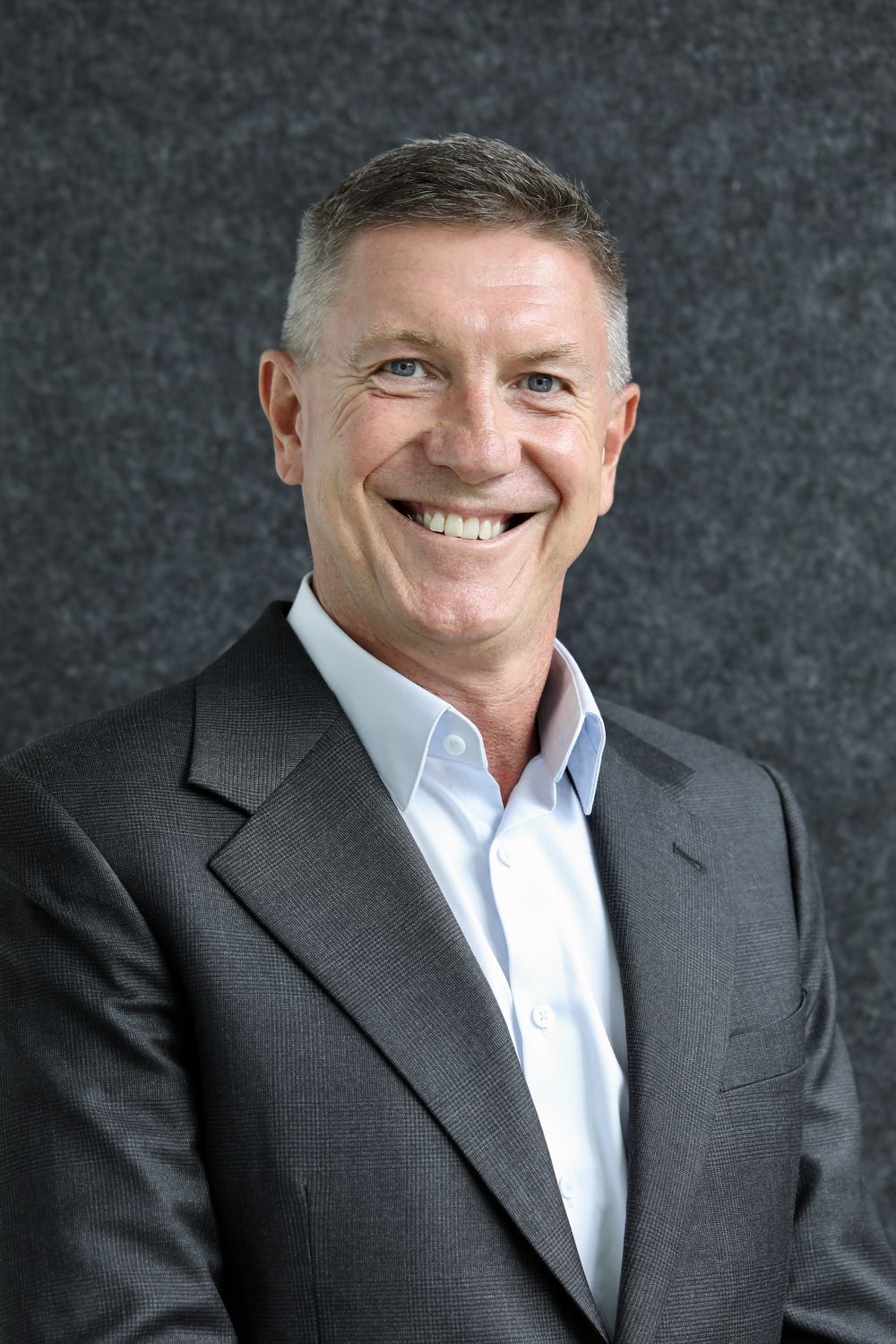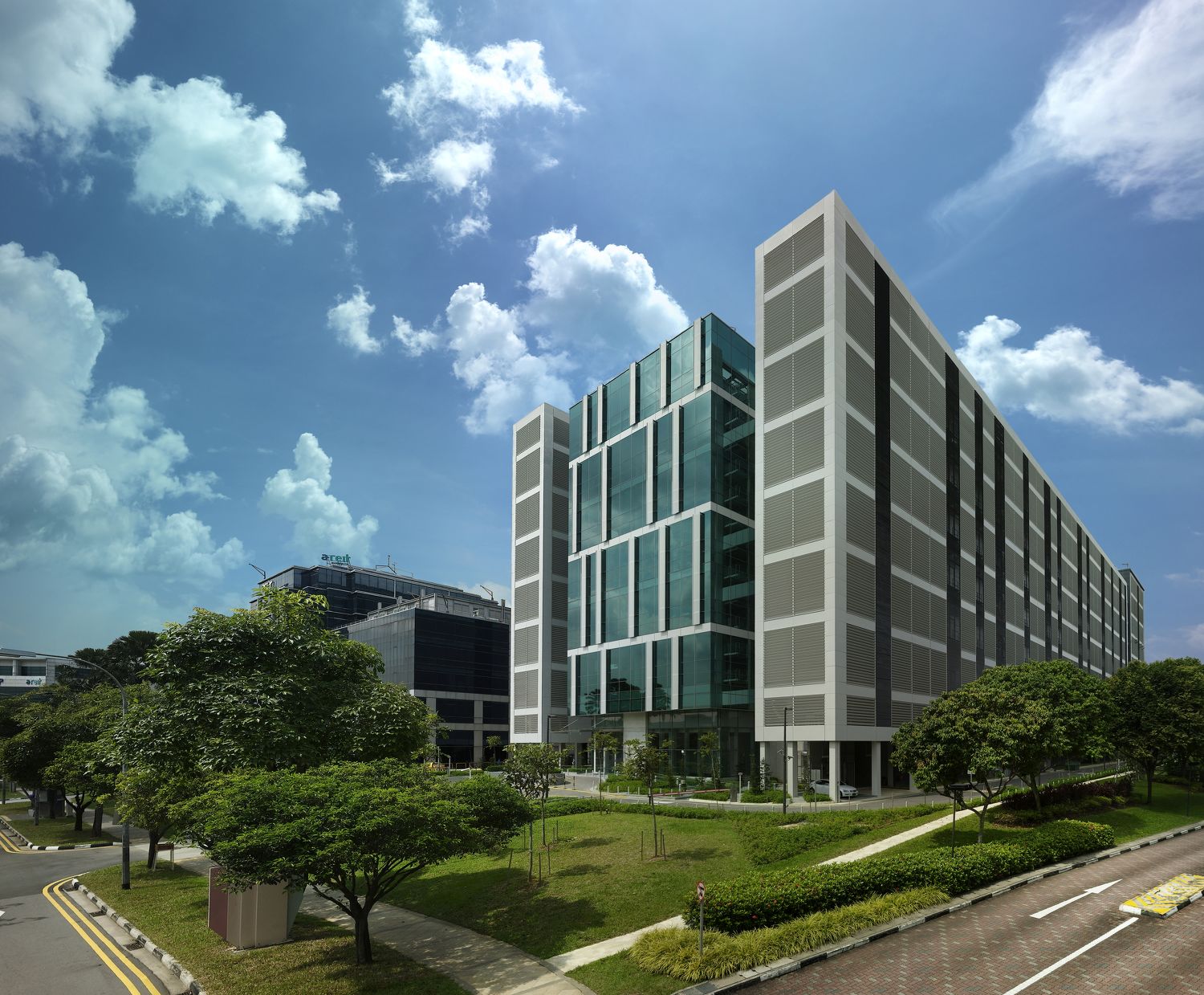Curry: Ask anyone in the data centre business and you’ll know that the biggest challenge about operating a data centre in Singapore is its environment. Photo: Digital Realty “Technology is going to continue to evolve and that technology is going to need somewhere to live,” says Jon Curry, vice-president of operations, Asia Pacific, at Digital Realty. So what are these operators, customers, and governments around the world doing to manage demand and concerns around environmental degradation caused by data centres?
Along the northwestern coast of England, some 380km away from London, lies the perpetually windy seaside town of Blackpool. Popular among locals as a quick weekend getaway destination, Blackpool is known for being wet, cold and bleak, especially during winter.
It is precisely these natural conditions that make it the perfect place to house wind farms — a source of unlimited renewable energy. Of late, Blackpool’s geographical position along the Irish Sea has led to another advantageous development — it joined the North Atlantic loop, a subsea fibre cable system providing high-capacity network connection from the US to Northern Europe.
With access to renewable energy and super-fast global Internet connection, Blackpool suddenly found itself on the map as a world leader in ethically powered data, making it a highly sought-after location for building data centres.
In late 2021, one of the world’s largest data centre operators, Equinix, announced plans to build a new international business exchange (IBX) data centre in Salford, Manchester, just an hour’s car ride away from Blackpool. Worth GBP61 million ($101.99 million), MA5 is Equinix’s fifth data centre in Manchester.
“It is home to low-latency connectivity through network routes to the US and has access to international subsea cables via Ireland and the west of England,” the company said in a press release on Oct 27, 2021. Blackpool’s proximity enables the design-build of MA5 to be sustainable, putting Equinix’s data centre on track to achieving its goal of using 100% clean and renewable energy and attaining green certifications, including the Leadership in Energy and Environmental Design (LEED) certification.
Increasingly, data centre operators worldwide have been working to “green” their business. Most have proudly announced their sustainability goals of running on 100% renewable energy by 2030 and reducing their power usage effectiveness (PUE) score — a metric used to determine the energy efficiency of a data centre — to under 1.3. An ideal PUE ratio is 1.0, which signifies that every unit of power is utilised solely by the IT equipment.
Like Equinix, other data centre operators have begun eyeing Blackpool and other cities as strategic locations for building their facilities. Lunar Digital and Kao Data are some that have announced expansion plans in nearby Manchester this year alone, all in the hopes of gaining access to clean energy and minimising latency (or delay in the transmission of data) in operations — and it is no wonder why.
When the world began to digitise, data centres also began to develop a bad reputation for being “energy guzzlers” and a bane to their immediate environment. For instance, it was recorded that the global data centre storage capacity in 2021 stood at 1,327 exabytes (EB). One EB is equivalent to one billion gigabytes (GB).
From the first data centre built during the 1940s to the dotcom boom followed by the pandemic which fuelled the growth of the global data centre market, the industry today is projected to reach EUR235 billion ($338.5 billion) by 2026 with a CAGR of 4.5% and shows no signs of slowing.
The carbon footprint of a data centre is made up of three parts; electricity consumption to run the servers, water consumption to cool the servers, and the lifetime of the equipment, which affects how often each part needs replacement.
On average, data centres each year consume an estimated 196 to 400 terawatt-hours (TWh), equivalent to 1% to 2% of the world’s global energy consumption, and just a one-megawatt (MW) data centre using traditional cooling systems consumes about 25.5 million litres of water.
Experts estimate that data centre activity accounts for 2.5% to 3.7% of all global greenhouse gas emissions, exceeding emissions from commercial flights (about 2.4%) and other essential activities that fuel our global economy. According to the Paris-based non-profit organisation The Shift Project, emissions generated from watching 30 minutes of Netflix are about 1.6 kg of CO2, the equivalent of driving almost 6km in your car.
It is no wonder that opposition to data centre development is growing. In March, farmers in the Netherlands objected to the building of a data centre by Microsoft in the wake of a nitrogen crisis, fearing that it could be worsened by its construction and operation. In July, a plan to build a Google data centre that will use millions of litres of water a day sparked anger in Uruguay, which is suffering its worst drought in 74 years.
But data centres are the backbone of today’s digital economy. They are critical for the storing, processing, and distributing of an organisation’s most critical and proprietary assets. The infrastructure houses data for the Internet, the banking industry, telecommunications and governments holding critical data of citizens.
Curry: Ask anyone in the data centre business and you’ll know that the biggest challenge about operating a data centre in Singapore is its environment. Photo: Digital Realty
“Technology is going to continue to evolve and that technology is going to need somewhere to live,” says Jon Curry, vice-president of operations, Asia Pacific, at Digital Realty.
So what are these operators, customers, and governments around the world doing to manage demand and concerns around environmental degradation caused by data centres?
Can data centres be green? Singapore is at the crossroads of 25 operating cables, with 14 more projects in the pipeline over the next 10 years, according to a report by Nikkei Asia on June 5. Unlike locations like Blackpool, it has no wind, limited land space, high cloud cover, and lots of data centre operators. By 2019, over 70 data centres in Singapore accounted for 7% of the energy consumed in the country. With an average of 15MW per data centre, the nation’s total IT capacity is just over one gigawatt (GW) today. In comparison, the Philippines’ total IT capacity stands at 50MW — an IT load 20 times smaller for almost 20 times more people. This has prompted a relook at the sustainability roadmap for data centres among regulators in Singapore. “Singapore was the second market in the world [after Amsterdam] to say: ‘Let’s pause and think about the way we want to build data centres because of the energy output it is taking up,’” says Wandrille Doucerain, head of business development data centre solutions at Engie Southeast Asia.
See also: Indonesia to levy large fines on miners breaching forest permits
Doucerain: Three key components make Singapore a good place to house data centres — stable power, stable political system, and critical minimal population size. Photo: Engie Engie, which is a global energy and services group headquartered in Paris, France, has worked with data centre operators in Singapore to advise them on their operations. One of its projects is a Keppel data centre with a 25MW capacity that amounted to a seven-storey building. Doucerain refers to the moratorium that Singapore imposed on the building of data centres in 2019, which was lifted three years later in July 2022. Since then, regulators have set a new standard of criteria for companies looking to build a new data centre here. Drawn up by the Infocomm Media Development Authority (IMDA) and the Economic Development Board (EDB), data centre operators would have to make their operations more “green” by reducing their PUE to 1.3 and propose newer cooling equipment methods which will use less energy. A year later, the Singapore government launched its pilot Data Centre — Call for Application (DCCFA) for 80MW of capacity, in which over 20 applications were filed. Eventually, a consortium of four awardees — AirTrunk-ByteDance, Equinix, GDS and Microsoft — were awarded 20MW of capacity each to build new facilities according to the new standards. Jonathan Lin, executive vice-president and general manager for data centre services at Equinix, attributes the win to having “provided a very aggressive environmental proposal” to IMDA. Lin shares that Equinix was the first data centre operator in the world to set the targets of attaining 100% renewable energy and being climate-neutral by 2030.
See also: Orsted shares advance after Trump wind ban ruled illegal
Lin: Equinix was the first data centre operator in the world to set the targets of attaining 100% renewable energy and be climateneutral by 2030. Photo: Equinix In its 2022 sustainability report, Equinix said that it consumed 7,750 GWh of electricity for both overhead infrastructure and customer IT load, an increase of 9% y-o-y. Of this, 96% was covered by renewable energy and y-o-y, Equinix has increased its procurement of renewables by 10% on a GWh-basis. However, sources of renewable energy in Southeast Asia are scarce, and the region is primarily dependent on coal. For a country like Singapore with high cloud coverage, it becomes all the more challenging for data centres to seek alternative energy sources to the main power grid, such as the construction of solar panels. Therefore, many operators have turned to power purchase agreements (PPAs), a contractual agreement between energy buyers and sellers, as an alternative solution. To date, Equinix has 715MW worth of PPAs under long-term contracts, of which 225MW are operational, while the remaining are under development. Perhaps this might be brushed off as a greenwashing attempt, but Curry of Digital Realty describes the unique difficulties of running a data centre in emerging markets with tropical climates. “Ask anyone in the data centre business and you’ll know that the biggest challenge about operating a data centre in Singapore is its environment,” says Curry. “The humidity, heat, and the inability to leverage the external environment to do anything are huge challenges.” In France, data centres that take too much power from the main power grid are often asked to give back, says Doucerain, citing an example of how data centres overseas have more alternatives to be sustainable. This means that some power will be reallocated back to the grid operator, while the heat produced by the IT equipment will be used to heat the surrounding areas during winter, including schools, swimming pools and houses. Singapore, with an average weather of 28ºC, is unable to do this, and so the industry has innovated. In June, IMDA launched a new sustainability standard of increasing operating temperatures of data centres in tropical countries (known as tropical data centres), to 26°C and above.
Digital Realty’s 24 MW data centre in Jurong. The data centre operator was one of the few that trialled IMDA’s tropical data centre standards by raising operating temperatures from 22°C to 26°C. Photo: Digital Realty The announcement came after a successful test trial conducted with some operators in Singapore, including Digital Realty. As cooling systems account for up to 40% of total energy consumption in the average data centre, most operators keep their operating temperatures at 22°C and below to avoid overheating the servers, which could damage the expensive equipment or compromise customers’ crucial data. But when Digital Realty successfully increased its operating temperatures by 2°C at two of its 4.5MW data halls in Singapore, Doucerain believes this will pave the way for a new sustainable standard moving forward. “This translates to a reduction of approximately 2%–3% total energy usage in these data halls over the trial period to date,” says IMDA. However, Curry notes the difficulty of implementing this new temperature standard in all existing data centre environments. Some existing infrastructures are legacy facilities, which are unable to make those changes without exceeding their risk tolerance, like banks, he says. These days, a new form of technology is being closely studied. Known as immersive cooling, operators can soon immerse an entire server rack into liquid directly to be cooled, instead of using cool air to manage heat. With an average output of 8 kilowatts (KW) per rack in terms of IT load, an immersive cooling solution can cool racks as strong as 150–200KW. “So it’s much bigger, which means you can use considerably less space,” explains Engie’s Doucerain. “Immersive cooling will use 75% less space on average, which is massive in a country where spaces are constrained.” He estimates that immersive cooling will allow data centres to multiply their IT load by two to three times in the same amount of space. “[In addition, immersive cooling] is way more efficient in terms of power usage, up to 50% more efficient than the traditional way of cooling a data centre. So you can see the interest for a place like Singapore — less space, more efficiency,” says Doucerain. At present, Doucerain estimates that 1MW of capacity is equivalent to US$10 million of investments. He believes that the four awardees of the DCCFA have some immersive cooling solutions in their proposals, which will increase the cost from an estimated US$800 million for the total 80MW of space allocated to about US$1 billion of financing. Although immersive cooling technology is not new, it has yet to be deployed as a large-scale solution. Should the data centres built from the DCCFA successfully implement immersive cooling into their infrastructure, Singapore will become one of the first countries to actively push that as a sustainable solution, says Doucerain, noting that several server manufacturers including 3M and Intel have already begun mass production.
Can data centres be green?
Singapore is at the crossroads of 25 operating cables, with 14 more projects in the pipeline over the next 10 years, according to a report by Nikkei Asia on June 5. Unlike locations like Blackpool, it has no wind, limited land space, high cloud cover, and lots of data centre operators.
By 2019, over 70 data centres in Singapore accounted for 7% of the energy consumed in the country. With an average of 15MW per data centre, the nation’s total IT capacity is just over one gigawatt (GW) today. In comparison, the Philippines’ total IT capacity stands at 50MW — an IT load 20 times smaller for almost 20 times more people. This has prompted a relook at the sustainability roadmap for data centres among regulators in Singapore.
“Singapore was the second market in the world [after Amsterdam] to say: ‘Let’s pause and think about the way we want to build data centres because of the energy output it is taking up,’” says Wandrille Doucerain, head of business development data centre solutions at Engie Southeast Asia.
Doucerain: Three key components make Singapore a good place to house data centres — stable power, stable political system, and critical minimal population size. Photo: Engie
Engie, which is a global energy and services group headquartered in Paris, France, has worked with data centre operators in Singapore to advise them on their operations. One of its projects is a Keppel data centre with a 25MW capacity that amounted to a seven-storey building.
Doucerain refers to the moratorium that Singapore imposed on the building of data centres in 2019, which was lifted three years later in July 2022. Since then, regulators have set a new standard of criteria for companies looking to build a new data centre here. Drawn up by the Infocomm Media Development Authority (IMDA) and the Economic Development Board (EDB), data centre operators would have to make their operations more “green” by reducing their PUE to 1.3 and propose newer cooling equipment methods which will use less energy.
A year later, the Singapore government launched its pilot Data Centre — Call for Application (DCCFA) for 80MW of capacity, in which over 20 applications were filed. Eventually, a consortium of four awardees — AirTrunk-ByteDance, Equinix, GDS and Microsoft — were awarded 20MW of capacity each to build new facilities according to the new standards.
Jonathan Lin, executive vice-president and general manager for data centre services at Equinix, attributes the win to having “provided a very aggressive environmental proposal” to IMDA. Lin shares that Equinix was the first data centre operator in the world to set the targets of attaining 100% renewable energy and being climate-neutral by 2030.
Lin: Equinix was the first data centre operator in the world to set the targets of attaining 100% renewable energy and be climateneutral by 2030. Photo: Equinix
In its 2022 sustainability report, Equinix said that it consumed 7,750 GWh of electricity for both overhead infrastructure and customer IT load, an increase of 9% y-o-y. Of this, 96% was covered by renewable energy and y-o-y, Equinix has increased its procurement of renewables by 10% on a GWh-basis.
However, sources of renewable energy in Southeast Asia are scarce, and the region is primarily dependent on coal. For a country like Singapore with high cloud coverage, it becomes all the more challenging for data centres to seek alternative energy sources to the main power grid, such as the construction of solar panels.
Therefore, many operators have turned to power purchase agreements (PPAs), a contractual agreement between energy buyers and sellers, as an alternative solution. To date, Equinix has 715MW worth of PPAs under long-term contracts, of which 225MW are operational, while the remaining are under development.
Perhaps this might be brushed off as a greenwashing attempt, but Curry of Digital Realty describes the unique difficulties of running a data centre in emerging markets with tropical climates.
“Ask anyone in the data centre business and you’ll know that the biggest challenge about operating a data centre in Singapore is its environment,” says Curry. “The humidity, heat, and the inability to leverage the external environment to do anything are huge challenges.”
In France, data centres that take too much power from the main power grid are often asked to give back, says Doucerain, citing an example of how data centres overseas have more alternatives to be sustainable. This means that some power will be reallocated back to the grid operator, while the heat produced by the IT equipment will be used to heat the surrounding areas during winter, including schools, swimming pools and houses.
Singapore, with an average weather of 28ºC, is unable to do this, and so the industry has innovated. In June, IMDA launched a new sustainability standard of increasing operating temperatures of data centres in tropical countries (known as tropical data centres), to 26°C and above.
Digital Realty’s 24 MW data centre in Jurong. The data centre operator was one of the few that trialled IMDA’s tropical data centre standards by raising operating temperatures from 22°C to 26°C. Photo: Digital Realty
The announcement came after a successful test trial conducted with some operators in Singapore, including Digital Realty. As cooling systems account for up to 40% of total energy consumption in the average data centre, most operators keep their operating temperatures at 22°C and below to avoid overheating the servers, which could damage the expensive equipment or compromise customers’ crucial data.
But when Digital Realty successfully increased its operating temperatures by 2°C at two of its 4.5MW data halls in Singapore, Doucerain believes this will pave the way for a new sustainable standard moving forward.
“This translates to a reduction of approximately 2%–3% total energy usage in these data halls over the trial period to date,” says IMDA.
However, Curry notes the difficulty of implementing this new temperature standard in all existing data centre environments. Some existing infrastructures are legacy facilities, which are unable to make those changes without exceeding their risk tolerance, like banks, he says.
These days, a new form of technology is being closely studied. Known as immersive cooling, operators can soon immerse an entire server rack into liquid directly to be cooled, instead of using cool air to manage heat. With an average output of 8 kilowatts (KW) per rack in terms of IT load, an immersive cooling solution can cool racks as strong as 150–200KW.
“So it’s much bigger, which means you can use considerably less space,” explains Engie’s Doucerain. “Immersive cooling will use 75% less space on average, which is massive in a country where spaces are constrained.”
He estimates that immersive cooling will allow data centres to multiply their IT load by two to three times in the same amount of space. “[In addition, immersive cooling] is way more efficient in terms of power usage, up to 50% more efficient than the traditional way of cooling a data centre. So you can see the interest for a place like Singapore — less space, more efficiency,” says Doucerain.
At present, Doucerain estimates that 1MW of capacity is equivalent to US$10 million of investments. He believes that the four awardees of the DCCFA have some immersive cooling solutions in their proposals, which will increase the cost from an estimated US$800 million for the total 80MW of space allocated to about US$1 billion of financing.
Although immersive cooling technology is not new, it has yet to be deployed as a large-scale solution. Should the data centres built from the DCCFA successfully implement immersive cooling into their infrastructure, Singapore will become one of the first countries to actively push that as a sustainable solution, says Doucerain, noting that several server manufacturers including 3M and Intel have already begun mass production.
The real estate behind the AI race Increasingly, neighbouring island Batam has seen an influx of data centre operation deals with average capacities of five times or more of the 20MW of capacity given to each awardee at the DCCFA. Batam is quickly becoming a hotbed for data centres — which begs the question, why do data centre operators still want to be based in Singapore? Engie’s Doucerain explains three key components make Singapore a good place to house data centres — stable power, a stable political system, and critical minimal population size. As one of the first few countries to build data centres on the back of the banking industry, Singapore’s regulators have clear rules on how to store and manage data within the country, an important nod to data sovereignty. Outside of sensitive data, however, customers of data centres are beginning to demand what is known as Singapore+1, a reference to operating centres which are still fairly close to the island to enjoy the same seamlessness of connectivity. A series of recent announcements have followed: leading cloud provider AWS announced in March its investment of US$6 billion in building data centres in Malaysia. In February, data centre operator Princeton Digital Group (PDG), which manages a 14MW facility in Singapore through a previous acquisition, said that it will be investing $1 billion in Batam, Indonesia and Johor. This is part of its “SG+ strategy” of expanding its data centre footprint around Singapore, with its first built into a 96MW campus in Batam.
Vantage, which plans to deliver a 256MW campus in Malaysia, is anticipating AI needs from its hyperscale customers, says its vicepresident of design and engineering in Asia Pacific, Donna Bridgman. Photo: Vantage Others such as Vantage, which opened its Asia Pacific headquarters in Singapore in May, have said that they are not seeing demand from their key customers in the Singapore market which they believe is saturated. Vantage, which has enjoyed operational success in Western markets, entered the region within the last 18 months. The data centre operator, which typically deploys facilities of 28MW and more, is focusing its operations in Malaysia, Hong Kong, Japan, and others. It most recently announced plans to deliver a 256MW campus in Malaysia, to meet “growing customer demand for hyperscale data centres” — a reference to large cloud providers such as AWS. This strategy of announcing plans to build large facilities allows politicians in countries that may not have regulations as robust as Singapore’s to trumpet their ambitions, says Doucerain. “The market is coming, and they need to make it as business-friendly as possible.” Another key aspect of having facilities of over hundreds of MW is an indicator to hyperscalers that a data centre operator has the ability to account for its technological growth, specifically, their ventures into artificial intelligence (AI). Vantage’s vice-president of design and engineering in Asia Pacific, Donna Bridgman, says that its key customers have signalled that they will be needing provision for AI in future deployments. “Accommodating for AI is in the works, certainly something we’re considering with our recent Malaysia campus,” she adds. But these are still early days, according to Equinix’s Lin, who says that the company has been supporting AI through machine learning requirements for more than a decade now. Amid the excitement surrounding generative AI, Lin believes that it is too early to know what customers’ demands for supporting such developments might look like. “There’s a tremendous amount of buzz and energy around AI, but how long will that sustain? What does that translate into on an annual basis?” says Lin. “We’re not yet in a position where we can say that we’re going to end up having to triple our amount of power requirements. But I think the question is: How do we make sure that as we’re going ahead and supporting those incremental growth requirements, we’re doing that as sustainably as possible?"
The real estate behind the AI race
Increasingly, neighbouring island Batam has seen an influx of data centre operation deals with average capacities of five times or more of the 20MW of capacity given to each awardee at the DCCFA. Batam is quickly becoming a hotbed for data centres — which begs the question, why do data centre operators still want to be based in Singapore?
Engie’s Doucerain explains three key components make Singapore a good place to house data centres — stable power, a stable political system, and critical minimal population size. As one of the first few countries to build data centres on the back of the banking industry, Singapore’s regulators have clear rules on how to store and manage data within the country, an important nod to data sovereignty.
Outside of sensitive data, however, customers of data centres are beginning to demand what is known as Singapore+1, a reference to operating centres which are still fairly close to the island to enjoy the same seamlessness of connectivity.
A series of recent announcements have followed: leading cloud provider AWS announced in March its investment of US$6 billion in building data centres in Malaysia. In February, data centre operator Princeton Digital Group (PDG), which manages a 14MW facility in Singapore through a previous acquisition, said that it will be investing $1 billion in Batam, Indonesia and Johor. This is part of its “SG+ strategy” of expanding its data centre footprint around Singapore, with its first built into a 96MW campus in Batam.
Vantage, which plans to deliver a 256MW campus in Malaysia, is anticipating AI needs from its hyperscale customers, says its vicepresident of design and engineering in Asia Pacific, Donna Bridgman. Photo: Vantage
Others such as Vantage, which opened its Asia Pacific headquarters in Singapore in May, have said that they are not seeing demand from their key customers in the Singapore market which they believe is saturated. Vantage, which has enjoyed operational success in Western markets, entered the region within the last 18 months.
The data centre operator, which typically deploys facilities of 28MW and more, is focusing its operations in Malaysia, Hong Kong, Japan, and others. It most recently announced plans to deliver a 256MW campus in Malaysia, to meet “growing customer demand for hyperscale data centres” — a reference to large cloud providers such as AWS.
This strategy of announcing plans to build large facilities allows politicians in countries that may not have regulations as robust as Singapore’s to trumpet their ambitions, says Doucerain. “The market is coming, and they need to make it as business-friendly as possible.”
Another key aspect of having facilities of over hundreds of MW is an indicator to hyperscalers that a data centre operator has the ability to account for its technological growth, specifically, their ventures into artificial intelligence (AI).
Vantage’s vice-president of design and engineering in Asia Pacific, Donna Bridgman, says that its key customers have signalled that they will be needing provision for AI in future deployments. “Accommodating for AI is in the works, certainly something we’re considering with our recent Malaysia campus,” she adds.
But these are still early days, according to Equinix’s Lin, who says that the company has been supporting AI through machine learning requirements for more than a decade now. Amid the excitement surrounding generative AI, Lin believes that it is too early to know what customers’ demands for supporting such developments might look like.
“There’s a tremendous amount of buzz and energy around AI, but how long will that sustain? What does that translate into on an annual basis?” says Lin. “We’re not yet in a position where we can say that we’re going to end up having to triple our amount of power requirements. But I think the question is: How do we make sure that as we’re going ahead and supporting those incremental growth requirements, we’re doing that as sustainably as possible?"






